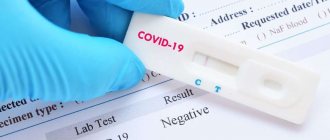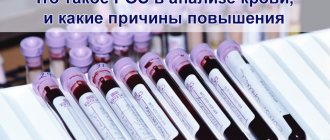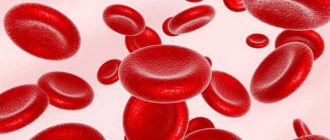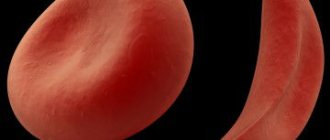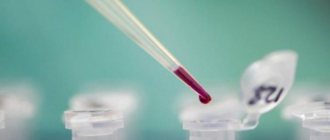What does ESR depend on?
If you take a flask, pour blood into it and then add an anti-clotting agent inside, the liquid will separate over time. Pure plasma will remain on top, and at the bottom there will be sediment, mainly consisting of red blood cells. This occurs under the influence of gravity due to the difference in weight.
The normal ESR level for an adult woman is in the range from 2 to 15 mm/h, for a man - from 2 to 12 mm/h. In a newborn child, regardless of gender, this figure is around 1-2 mm/h.
University
→ Home → University → University in the media → Disease or normal? What will the ESR tell you?
A clinical blood test ranks first in the list of mandatory methods for assessing our health and is important for identifying a number of diseases. Despite the fact that the blood of a healthy person strives for constancy in its quantitative and qualitative composition, in everyday practice doctors note certain fluctuations. This also applies to the erythrocyte sedimentation rate (ESR). And although a competent interpretation of a general blood test is within the competence of a doctor, some general understanding of hematological parameters will help, if something happens, to contact a specialist in a timely manner. What is hidden behind the abbreviation “ESR” and should you worry if the result does not coincide with the norm?
The erythrocyte sedimentation rate measures how quickly the blood separates into plasma (the liquid part) and formed elements. If you add an anticoagulant (a substance that prevents clotting) to a vertically mounted test tube, the blood will gradually separate into two layers under the influence of gravity: translucent plasma will be on top, and settled red blood cells will be at the bottom. Thus, ESR is estimated by the height (in millimeters) of the top layer formed within one hour. The normal value of this indicator depends on age, gender and certain physiological conditions of the body (for example, pregnancy, menstruation). In an adult, ESR can fluctuate within a fairly wide range: 0 - 15 mm/h in men and 0 - 20 mm/h in women, which is associated with gender and other differences in the chemical composition of the blood and its level of viscosity. During pregnancy (starting from the 5th week) and in the postpartum period, ESR values increase to 20 - 25 mm/h, and in older people they can reach 30 mm/h and higher. In some cases, an increase in ESR above normal is associated with the presence of bad habits (smoking, addiction to alcohol), the nature of the diet (low-calorie
diet or, conversely, overeating), individual characteristics of the body. Let's say, according to some data, almost 5% of the planet's population has an accelerated erythrocyte sedimentation reaction from birth, but there are no obvious pathological reasons for this. Therefore, if you receive an analysis result with an elevated ESR level, you should first exclude the influence of the factors listed above. Otherwise, too rapid precipitation of red blood cells is a sign of the development of one or even several inflammatory (including infectious) diseases: viral hepatitis, influenza, pneumonia, pyelonephritis, rheumatism, arthritis, etc. After all, inflammatory processes in the human body lead to the accumulation of special protein molecules in the blood that accelerate the reaction of red blood cell adhesion. Other causes of high ESR may include previous trauma or surgery, anemia, pathology of the kidneys or thyroid gland, malignant tumors, or taking certain medications (estrogens, oral contraceptives). A reduced (close to zero) level of ESR is relatively rare and is caused primarily by chronic heart and liver diseases, excess production of red blood cells, treatment with aspirin, prednisolone, etc. In order for the results of the analysis (especially the detailed one) to be reliable, it is advisable to donate blood for research on an empty stomach or at least no earlier than 4 hours after a meal, excluding increased physical activity the day before, stress and anxiety, as well as alcohol consumption. And remember: it is impossible to make a correct diagnosis based only on the ESR indicator - this requires the participation of a specialist doctor and, as a rule, a more in-depth examination. Vladimir KHRYSCHANOVYCH , Doctor of Medical Sciences
Soviet Belarus , November 22, 2018
Share
Possible causes of increased ESR
The most noticeable effect on this parameter is fibrinogen, a colorless protein in the plasma that is involved in blood clotting, wound and tissue healing, and the body’s immune defense.
If fibrinogen increases, ESR also increases. The amount of this protein can be increased as a result of:
- Inflammatory processes, especially in the acute phase;
- Burns and frostbite;
- Metabolic disorders (such as diabetes);
- Oncology development;
- Rheumatism;
- The appearance of tumors;
- Necrotic processes;
- Stroke or myocardial infarction;
- Hormonal changes;
- Taking certain medications.
The number of red blood cells can also affect ESR. If it is reduced, then the rate of their precipitation is higher. This can happen due to significant blood loss, anemia, and other pathologies of the circulatory system.
Patients with coronavirus also experience an increased erythrocyte sedimentation rate.
Although a high ESR value in itself is not a problem, it can indicate a wide range of diseases, including very serious ones.
Poor results are a reason to undergo additional research. Which ones specifically? This is decided based on the clinical picture, anamnesis, and personal characteristics of the patient.
Detailed description of the study
ESR (erythrocyte sedimentation rate) is a nonspecific indicator that reflects the presence of any inflammation in the body.
This method is available in all laboratories and is easy to perform, which allows you to quickly assess the patient’s condition and the effectiveness of the treatment.
ESR is an indicator that indicates the rate of separation of blood into upper and lower layers with the obligatory addition of an anticoagulant - a substance that reduces blood clotting. The specific gravity of red blood cells is greater, so due to gravity they end up at the bottom. The top layer contains plasma, and the bottom layer contains red blood cells. The speed is estimated by the height of the appearance of the plasma and is measured in millimeters per hour.
All red blood cells have the same electrical charge on their surface. This property allows them not to stick together in the blood, but to repel each other. When the charge on the membrane changes, they stick together and form so-called “coin columns”.
An increase in ESR is almost always proportional to an increase in the concentration of leukocytes and CRP (C-reactive protein) - other nonspecific markers of inflammation. With increased formation of proteins in the acute phase of inflammation, as well as with changes in the qualitative and quantitative state of red blood cells, a change occurs in the cell membrane, which leads to their gluing and, as a consequence, an increase in ESR.
The process of erythrocyte sedimentation is divided into 3 phases:
- Slow sedimentation in the form of individual cells;
- “Columns” form, and the settling process accelerates;
- Gluing of red blood cells with a gradual cessation of any movement.
The erythrocyte sedimentation rate is a variable value and depends on a large number of factors, both physiological and pathological:
- In women, the ESR is normally slightly higher than in men;
- During pregnancy, ESR is slightly increased due to changes in blood composition, especially protein;
- With anemia - a reduced concentration of red blood cells in the blood) - an acceleration of ESR is observed;
- With an increased concentration of erythrocytes in the body, a slowdown in sedimentation rate is observed;
- During the day, there is a fluctuation in speed and the maximum value can be recorded during the day;
- Newborns have a minimum sedimentation rate, this is due to a high concentration of red blood cells and a small amount of serum proteins;
- A latent inflammatory process that can go away on its own within a few months (extremely rare);
- Oncological and autoimmune diseases;
- For diseases of the thyroid gland: thyrotoxicosis, hypothyroidism;
- Morphological changes in erythrocytes - anisocytosis, spherocytosis, macrocytes - also affect their sedimentation rate.
Erythrocyte sedimentation rate is a nonspecific indicator and can change for various reasons. Therefore, for a complete diagnosis of the condition, it is important to supplement the analysis with a general blood test with leukocyte count and C-reactive protein. To assess the condition, it is important to perform a dynamic analysis, since an increase in ESR is observed a day after the onset of the inflammatory process, and a decrease is a long-term process that can last up to a week.
Assessing the erythrocyte sedimentation rate is important to detect inflammation in the body. In autoimmune diseases, the use of this indicator helps to determine the activity of the disease and evaluate the effectiveness of treatment.
What does a low erythrocyte sedimentation rate indicate?
This indicator may be below normal due to:
- Following a strict vegetarian diet;
- Violations of water-salt balance;
- Diseases of the nervous system;
- Fasting;
- Excessive physical activity;
- Taking certain steroid hormones;
- Congenital disorder of the hemoglobin protein structure;
- Pregnancy in the second and third trimesters.
Decreased values are much less common than increased values. Often they do not mean any serious violations. Yet sometimes it is a low erythrocyte sedimentation rate that helps the doctor identify the problem. Or at least understand in which direction to look for it, what studies to prescribe for the patient.
Make an appointment now!
Leave your contact details or call and our manager will contact you to make an instant appointment
What does an increase in platelet levels in the blood indicate?
The upper limit of normal platelets in a blood test is 400 thousand/µl. Increased platelet levels are much more likely to occur for physiological reasons. These are so-called reactive thrombocytosis. Their cause may be recent physical overexertion, past stress, dehydration, that is, physiological thickening of the blood. Pathological factors most often include those that also thicken the blood - anemia due to chronic blood loss or acute blood loss, dehydration as a result of intoxication. The reasons for an absolute increase in platelet levels include inflammatory diseases, tuberculosis, malignant neoplasms in general and the hematopoietic system in particular.
An increase in platelet levels above 500 thousand/µl significantly increases the risk of thrombosis and requires the selection of antiplatelet therapy - the use of special drugs.
How to prepare for a blood test for ESR?
In order for the result of the procedure to be as reliable as possible, you need to prepare for it. It is a well-known fact that you need to donate blood on an empty stomach - and this is usually not forgotten. However, this is not the only recommendation. You also need:
- Temporarily, for 1-2 days before taking the test, give up alcohol;
- Refrain from fatty and spicy foods the day before;
- Do not smoke at least 2-3 hours before the procedure;
- Avoid physical activity immediately before blood collection.
You should also tell your doctor about the medications you are taking. Some medications can affect test results.
What does a decrease in platelet levels in the blood indicate?
The lower limit of normal blood platelet content is 150 thousand/μl. The reason for the decrease in PLT (platelet designation in a blood test) may be numerous but rare congenital thrombocytopenias (Fanconi syndrome, Wiskott-Aldrich, etc.), as well as acquired thrombocytopenias. The most common cause of acquired ones is the constant use of antiplatelet drugs, especially with two-component therapy (acetylsalicylic acid + clopidogrel); fortunately, the number of platelets in this case is usually not greatly reduced. Other causes of low blood platelets include bacterial and viral infections, anemia, splenomegaly, congestive heart failure, etc.
Clinical signs of platelet deficiency (bleeding gums, bruising, frequent hemorrhages in the sclera, etc.) appear when the platelet level drops below 50 thousand/µl - this is the indicator when you need to see a hematologist immediately.
Two methods of performing a laboratory blood test for ESR
In Russia, two approaches to conducting this analysis are widespread. They differ in the degree of accuracy, the type of biological material being analyzed and the procedure for collecting it.
1.According to Panchenkov
To perform this test, capillary blood is usually taken from a finger. It is mixed with a special anticoagulant that prevents clotting in a ratio of 1 to 4. Then it is placed in a Panchenkov stand - a glass tube with a stand and a scale with 100 divisions. After an hour, when the blood is divided into plasma and heavier formed elements (erythrocytes, platelets and leukocytes), a measurement is taken.
This method is extremely common in the post-Soviet space.
2.According to Westergren
According to the method, blood is first taken from a vein. Then the analyzed material is mixed with an anticoagulant and placed in a special tube 300 mm high. Moreover, it is filled to ⅔. measurements are taken within an hour. It turns out that the result is assessed on a scale with 200 divisions - its accuracy is higher.
Westergren analysis complies with international standards.
Note! In 5% of the total population of the world, ESR indicators from birth differ from the standard. And this is not accompanied by any pathologies.

